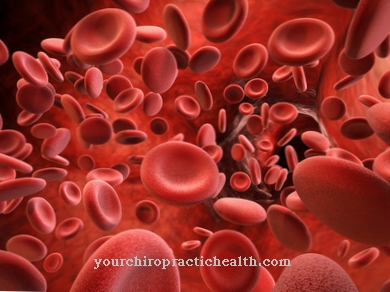The Vascular constriction, also as Vasoconstriction is the result of contractions of the tunica media. These contractions are either triggered by an increase in sympathetic tone or they are hormonally controlled. Pathological vascular constrictions are symptomatic, for example, with atherosclerotic plaques.
What is vascular obstruction?

The blood vessels in the human body are equipped with what are known as vascular muscles. This smooth tunica media is capable of toning the blood and lymphatic systems through contraction. It reacts to hormonal and neural stimuli.
The physician understands vascular constriction to mean a narrowing of the bloodstream, which is caused by the contraction of the tunica media. The blood flow is reduced by the contraction of the vascular muscles, as this reduces the lumen of the vessels. This muscular and blood pressure regulating constriction of the vessels is also called Vasoconstriction.
The relaxation of the tunica media is called vasodilation and is to be understood as the opposite of vascular constriction. The blood vessels expand during vasodilation and thus enlarge their lumen. The blood circulation is increased.
Vascular relaxation and constriction can be consciously triggered by various substances. If the tunica media is to be stimulated to contract, this is done, for example, by giving so-called vasoconstrictors.
Function & task
Physiological vasoconstriction is triggered by neuronal stimuli from the sympathetic nervous system and hormonal stimuli. By reducing the cross-section of the blood vessels, the blood flow behind the respective section of the blood vessels is also reduced. The necessary contraction of the smooth tunica media is controlled by visceromotor nerve fibers in the vegetative nervous system and triggered either by an increase in the sympathetic tone or by messenger substances such as AVP, adrenaline and thromboxane.
Vascular constriction primarily affects smaller arteries and plays a role in the body's own processes such as sympathetic-mediated thermoregulation. The thermoregulatory processes are controlled by the hypothalamus and depend on the tone of the sympathetic nervous system. High tones indicate loss of heat to the hypothalamus. The body temperature of a warm-blooded animal has to be kept relatively constant in the warm range so that there is an ideal environment for properties such as nerve conductivity. The hypothalamus therefore initiates a counter-regulating response when heat is lost. This includes, for example, vasoconstriction.
In the peripheral blood vessels, a high sympathetic tone leads to a-adrenergic vascular constriction, which restricts the blood flow in the extremities. The higher the blood flow, the more heat is lost on the body surface. With the thermoregulatory throttling of the blood flow, heat is saved at cold temperatures or otherwise threatened heat losses.
The vasoconstriction can, however, also be initiated by hormones. The blood vessels are equipped with certain receptors, for example with the so-called α-receptors for noradrenaline. Hormones such as angiotensin, serotonin or thromboxane A2, endothelin and norepinephrine bind to these receptors. In a state of shock, for example, certain hormones can ensure that too much blood does not leak from open wounds.
Stress hormones and shock hormones such as adrenaline, for example, mediate a contraction of smooth muscles in organs with a1 adrenoreceptors. Physiologically, open wounds initially bleed profusely to flush pollutants from the tissue. The release of vasoconstricting hormones prevents the wounds from bleeding after a long time, in order to prevent major blood loss. In medicine, for example, adrenaline is used to narrow blood vessels in order to stop bleeding.
Illnesses & ailments
In reversible cerebral vasoconstriction syndrome, the mechanism of vascular constriction is affected by painful symptoms. The disease is also called Call Fleming Syndrome and causes constriction of the brain vessels, which causes headaches and can favor strokes. Epileptic seizures can also occur as part of the disease. It affects patients of all ages.
Vascular constriction also plays a role in phenomena such as the Bayliss effect, which describes the contraction reaction of the blood vessels in the regulation of a local blood circulation in order to maintain constant blood flow to organs and tissues. The Bayliss effect mainly affects the kidneys, the gastrointestinal tract and the brain.
When the blood pressure increases, the wall expansion of the arteries in the organs mentioned changes, which is automatically compensated for by the contraction of the tunica media. Only when the intravascular pressure subsides do the smooth vascular muscles open again. Even with fluctuations in blood pressure, a constant blood flow to the organs is maintained.
This type of circulatory regulation is independent of the vegetative innervation. From a medical point of view, this effect plays a role primarily in nerve injuries. If such injuries are present, the Bayliss effect is retained. If the effect can no longer be observed, there is more than just a nerve injury.
The vascular constriction is also a symptom of atherosclerotic plaques and is triggered in the context of atherosclerosis by a malfunction of the endothelium, whose substances prevent the accumulation of blood cells in the context of the disease.
A pathological congestion of the kidney vessels, on the other hand, occurs in the hepatorenal syndrome, which can trigger oliguric kidney failure in patients with liver diseases.
The vascular constriction also plays a role in the hypoxic pulmonary vasoconstriction in the context of the ventilation / blood flow ratio of the lungs. In all diseases with alveolar hypoxia, complaints relating to hypoxic pulmonary vasoconstriction occur, for example in pneumonia or chronic obstructive pulmonary diseases.

.jpg)

























